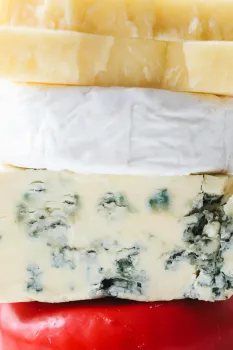Monica Benavides, UC Master Food Preserver Online Program Volunteer

So you found mold on your preserved food. Is it safe to cut or scrape off? Should you toss the whole thing? What is a home food preserver to do?
Here’s your research-based guide to help you make the safe choice.
Mold is a part of that special kingdom called fungi. When it comes to food preservation, mold isn’t necessarily all bad. In fact, some cheeses such as Brie and blue cheese are made with mold. However, when you see mold growth that wasn’t a part of the manufacturing process on your food, it’s due to microbial spoilage. This mold is not only undesirable, potentially causing allergic reactions and respiratory problems[TA1] [HS2] , it can even be dangerous by producing mycotoxins (toxic substances produced by some fungi). These poisonous substances are not visible to the naked eye, have no distinctive taste or odor, and can cause you to become seriously ill.
I grew up thinking that a little mold could just be scraped or cut off. I thought that if the rest of the food looked good, that it would be fine to eat. That’s not necessarily the case though. Use the table below, which summarizes the recommendations from the resources listed at the end of this article, to determine when it’s safe to cut off or remove a small piece of mold, and when you should dispose of the entire product.
| Preserved Product | What To Do | Why? |
| High- & Low-Acid Canned Goods* - Fuzzy growth on surface of the food, musty odor, slimy food. | Discard. | Mold is a sign of spoilage. This could be due to a broken seal, grossly under processed food, or improper storage. In the cause of jams and jellies, too little sugar can lead to the formation of mold. Mold can cause a reduction of acidity in pickles, fruit, and tomatoes, potentially leading to the growth of botulism-causing bacteria. |
Pickles – Soft and slippery. | If caused by microbial spoilage, then discard. | This could have been caused by a number of reasons:
|
Sauerkraut – mold during fermentation. | If a small amount of mold develops, it can safely be skimmed off. However, if a large amount of mold grows, then it can affect not only the flavor, but the safety of the kraut and should be discarded. | Mold may form on the surface if the sauerkraut is fermenting in too warm of an environment and not covered well. |
| Cold Storage Goods | Discard all moldy food except for hard cheese and firm fruits and veggies. In the case of hard cheese and firm fruits and vegetables, you can cut off the moldy area, removing at least 1 inch below the mold. Be sure not to cut through the mold and cross contaminate. | Mold growth is exacerbated by warmth and high humidity. However, mold can slowly grow in cold temperatures as well. Food exposed to oxygen and mold spores can develop this microbial spoilage even in cold temperatures. However, mold cannot easily penetrate dense hard cheese and firm fruits and vegetables (such as carrots and cabbage with low moisture content). |
| Moldy Dried Foods | Discard | Excess water content can cause mold growth on dried foods. Water activity higher than 0.7 can lead to the growth of mold. Either dry foods longer or store dried foods in the freezer. |
*Applesauce is a prime candidate for mold due to its thick consistency. Be sure to heat applesauce to at least 180°F before filling into sanitized jars. This will ensure proper heat penetration during the canning process.
We know that it takes time, care and a lot of energy to carefully preserve our food. No one wants to find mold on their preserved foods, but it happens to the best of us. Being informed about the best way to handle a moldy situation will help us make the safest choice of what to do. Regardless of the preserved food, a good fail-safe policy is: when in doubt, throw it out.
If you would like to learn more about mold, ways to prevent it and what to do if you find moldy food, then you may want to read this article by the USDA: https://www.fsis.usda.gov/food-safety/safe-food-handling-and-preparation/food-safety-basics/molds-food-are-they-dangerous
Resources:
Food Safety and Inspection Service, U.S. Department of Agriculture (2013, August 22). Molds on Food: Are They Dangerous? https://www.fsis.usda.gov/food-safety/safe-food-handling-and-preparation/food-safety-basics/molds-food-are-they-dangerous
Powers-Hammond, L. & McCurdy, S. (2018). Fundamentals of consumer food safety and preservation: Master handbook (California ed.) Washington State University Extension and University of California Agriculture & Natural Resources
